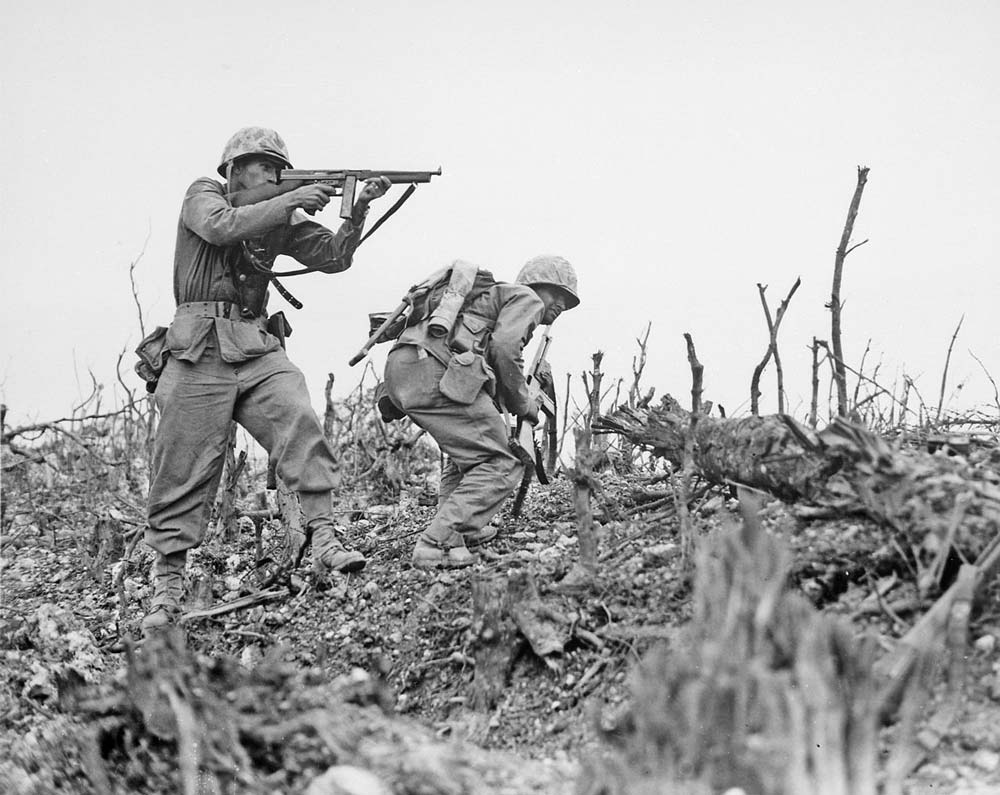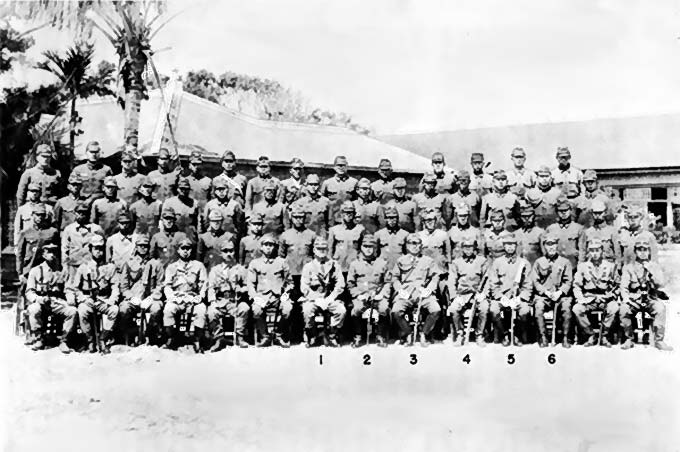| Battle of Okinawa | |||||||
|---|---|---|---|---|---|---|---|
 |
|||||||
|
|||||||
| Contenders | |||||||
| Military Leaders | |||||||
| Unit Strength | |||||||
| 183,000 | 120,000 | ||||||
| Casualties and Deaths | |||||||
| Total: 84,570 | Total: 105,755+ | ||||||
| 12,513 killed 38,916 wounded, 33,096 non-combat losses |
About 95,000+ killed 7,400–10,755 captured |
||||||
| Part of World War II | |||||||
The Battle of Okinawa, also known as Operation Iceberg, formed a part of the Pacific War during World War II. Fought in the spring of 1945, it was the biggest amphibious assault in that theater. The battle resulted in victory for the Allies, with huge casualties being inflicted on the Japanese army despite substantial losses for the Americans as well. This proved to be almost the last serious defense of Japanese territory before the end of the war in August.
Background
Okinawa is the principal island of the Rkyukyus archipelago, which lies at the extreme southern tip of Japan. It is only a few miles wide and around 60 miles in length, but its small dimensions are misleading: the island was one of the most strategically important locations in the whole country. In particular, no fewer than four air bases were situated on Okinawa, and estimates by U.S. intelligence services suggested that about 65,000 Japanese troops were stationed there to defend the island.
Unfortunately for the Americans, their intelligence was patchy at best, and in fact they had greatly underestimated the size of the defensive forces on Okinawa. There were in fact more than 130,000 troops stationed there, under the command of Lt. General Ushijima.
He had been ordered to maintain Japanese control over the island, no matter how great the cost. Most of the troops were located in the south of the island, but Okinawa also contained almost half a million civilians who had been unable to leave.
The American plan for final victory in the Pacific had several aspects, but the capturing of Okinawa was at the plan’s core. The main strategic objective, apart from gaining territory from the Japanese, was twofold. First, the capture of the island’s airfields would allow U.S. planes to use them as bases from which they could bomb the industrial centers of Japan. Second, the remnants of Japan’s merchant shipping fleet were to be destroyed in order to cut off supplies to the enemy.
Preparations for the Battle
 The Japanese under Ushijima resolved to concentrate their men at the southern end of Okinawa, with troops stationed in a number of secure fortified posts throughout the area. The idea was that only a dangerous frontal assault by the American attackers would have a realistic hope of capturing the forts. Meanwhile, the supreme Japanese command in Tokyo ordered that kamikaze suicide attackers be used in order to inflict the maximum possible casualties on the U.S. forces, with the expectation that this would force them to retreat.
The Japanese under Ushijima resolved to concentrate their men at the southern end of Okinawa, with troops stationed in a number of secure fortified posts throughout the area. The idea was that only a dangerous frontal assault by the American attackers would have a realistic hope of capturing the forts. Meanwhile, the supreme Japanese command in Tokyo ordered that kamikaze suicide attackers be used in order to inflict the maximum possible casualties on the U.S. forces, with the expectation that this would force them to retreat.
In command of the 180,000 American forces on the ground was Lt. General Simon Bolivar Buckner; his troops were told to make a landing along the western coast of Okinawa, at Hagushi Bay. Influenced by the lessons they had learned at Iwo Jima a few weeks earlier, the Americans subjected the area to heavy bombardment for some time before making a landing. However, U.S. soldiers were left vulnerable to attack by enemy fighter aircraft, taking off either from the nearby Japanese mainland or from the island of Taiwan.
In late March, in advance of the main assault, units of the 77th Division were landed 20 miles from Hagushi Bay. Once they had secured an anchorage, the main invasion would begin. The anchorage was successfully secured by the last day of March, and on April 1, the attack on Okinawa began, despite continuing attacks from kamikaze pilots on American ships.
The Landings Begin
 Although the large majority of the kamikaze attacks – nearly 200 of them in all – were destroyed by American fire, around two dozen succeeded in hitting their targets. The most significant damage was done to aircraft carriers, which unlike their British counterparts did not have armored flight decks at this time. Nevertheless, the difficulty caused to the American fleet was less than it might have been, thanks to the low proportion of the planes that made it through at all.
Although the large majority of the kamikaze attacks – nearly 200 of them in all – were destroyed by American fire, around two dozen succeeded in hitting their targets. The most significant damage was done to aircraft carriers, which unlike their British counterparts did not have armored flight decks at this time. Nevertheless, the difficulty caused to the American fleet was less than it might have been, thanks to the low proportion of the planes that made it through at all.
The United States force for the invasion itself consisted of almost 1,500 ships, of which only a fifth were warships, the rest being used for transport, supplies, etc. On April 1, U.S. Marines made their first landing on Okinawa, and were surprised to encounter only light resistance from the Japanese. By nightfall, Hagushi bay had seen 60,000 military personnel come ashore. Many of these pushed north, where the lightly defended countryside was easily taken; by April 20, the northern half of Okinawa was effectively secured.
The southern portion of the island, where the bulk of the Japanese defensive forces had been stationed, proved to be a much harder nut to crack. The XIV Corps, made up of four infantry divisions, reached the Machinato Line on April 4, and this brought about a halt in their previous steady advance. It took almost three weeks to breach the line, after which the secondary Shuri Line also caused severe delays. The time that it took the Americans to break through these lines resulted in heavy casualties.
Later Stages and Aftermath
Ushijima, seeing that things were going badly for his men, ordered them to counter-attack on May 3, but the assault was repulsed by U.S. soldiers. On May 21, he was forced to order a retreat from the Shuri Line, although at this point morale remained reasonably high and resistance continued. As the battle wore on, however, and further losses followed, the Japanese lost heart and in late June, Ushijima committed suicide. On July 2, the Americans declared Okinawa secure.
The Battle of Okinawa proved to be a colossal military defeat for Japan, one of its worst of the entirety of World War Two. Well over 100,000 Japanese troops were killed, with another 7,000 taken as prisoners of war. Japanese aircraft losses totaled over 4,000. Despite its victory, the U.S. had also suffered substantial losses: on land and at sea together, over 12,000 Americans were killed and over 36,000 wounded. 36 American ships and nearly 800 aircraft were also destroyed.
Despite the humiliation of having been crushed in battle at Okinawa, Japan resolved to fight on. At one point, it seemed as though a full-scale land invasion of the Japanese mainland might be necessary, an operation which would undoubtedly have cost enormous numbers of lives. In the event, Japan was forced to announce its surrender in early August, after the U.S. had dropped atomic bombs on the cities of Hiroshima and Nagasaki.